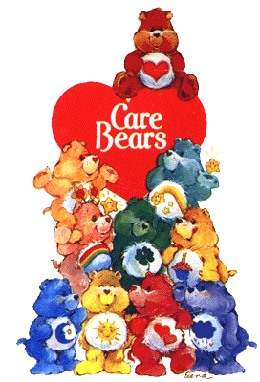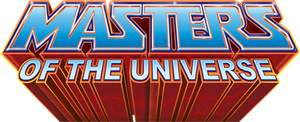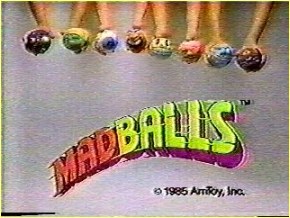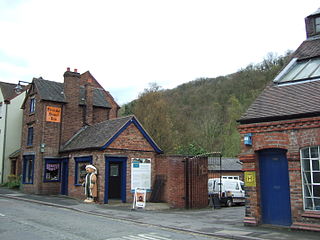Wallace and Gromit is a British stop-motion animated comedy franchise created by Nick Park and produced by Aardman Animations. The main film series consists of four short films and one feature-length film, and has spawned numerous spin-offs and TV adaptations. The series centres on Wallace, a good-natured, eccentric, cheese-loving inventor, and Gromit, his loyal and intelligent anthropomorphic beagle. The first short film, A Grand Day Out, was finished and made public in 1989. Wallace was voiced by actor Peter Sallis until 2010 when he was succeeded by Ben Whitehead. Gromit is largely silent and has no dialogue, communicating through facial expressions and body language.

A teddy bear is a stuffed toy in the form of a bear. Developed apparently simultaneously by toymakers Morris Michtom in the U.S. and Richard Steiff under his aunt Margarete Steiff's company in Germany in the early 20th century, the teddy bear, named after President Theodore Roosevelt, became a popular children's toy and has been celebrated in story, song, and film.

A stuffed toy is a toy doll with an outer fabric sewn from a textile and stuffed with flexible material. They are known by many names, such as plush toys, plushies, stuffed animals, and stuffies; in Britain and Australia, they may also be called soft toys or cuddly toys. The stuffed toy originated from the Steiff company of Germany in the late 19th century and gained popularity following the creation of the teddy bear in the United States in 1903. At the same time, German toy inventor Richard Steiff designed a similar bear. In 1903, Peter Rabbit was the first fictional character to be made into a patented stuffed toy. In 1921, Christopher Robin's stuffed toy, given to him by his father, A. A. Milne, would inspire the creation of Winnie-the-Pooh. In the 1970s, London-based Hamleys, the world's oldest toy store, bought the rights to Paddington Bear stuffed toys. In the 1990s, Ty Warner created Beanie Babies, a series of animals stuffed with plastic pellets that were popular as collector's items.

Chill is an investigative and modern horror role-playing game originally published by Pacesetter Ltd in 1984 that captures the feel of 20th-century horror films.

Care Bears are multi-colored bears, painted in 1981 by artist Elena Kucharik to be used on greeting cards from American Greetings. They were turned into plush teddy bears and featured in The Care Bears in the Land Without Feelings (1983) and The Care Bears Battle the Freeze Machine (1984) before headlining their own television series called Care Bears from 1985 to 1988. They also had multiple feature films including: The Care Bears Movie (1985), Care Bears Movie II: A New Generation (1986), and The Care Bears Adventure in Wonderland (1987).

The Jim Henson Hour is a television series that aired on NBC in 1989. It was developed as a showcase for The Jim Henson Company's various puppet creations, including the Muppet characters.

Masters of the Universe is a sword and planet-themed media franchise created by Mattel. The main premise revolves around the conflict between He-Man and Skeletor on the planet Eternia, with a vast lineup of supporting characters in a hybrid setting of medieval sword and sorcery, and sci-fi technology. A follow-up series, She-Ra: Princess of Power revolves around He-Man's sister She-Ra and her rebellion against The Horde on the planet Etheria. Since its initial launch, the franchise has spawned a variety of products, including multiple lines of action figures, six animated television series, several comic series, video games, books and magazines, a daily newspaper comic strip, and two feature films.

Teddy Ruxpin is an animatronic children's toy in the form of a talking bear-like creature called an 'Illiop'. The toy's mouth and eyes move while he reenacts stories played on an audio tape cassette deck built into its back. While the character itself was created by Ken Forsse, the talking toy was designed and built by Forsse’s Alchemy II, Inc. employees, including Larry Larsen and John Davies. Later versions have a digital cartridge in place of a cassette.

Werewolf is an American horror series, and one of the original shows in the Fox network's broadcast line-up during its inaugural season of 1987–1988.

Madballs is a series of toy foam balls originally created by AmToy, a subsidiary company of American Greetings in the mid-1980s, later being revived by Art Asylum (2007–2008) and Just Play, Inc. (2017–2019). The balls incorporated gross-out humor and each was given a character synopsis and an odd name. The toyline expanded into a franchise with comic books, direct-to-video cartoons, and a video game for the ZX Spectrum, Amstrad CPC, and Commodore 64.

Merrythought is a toy manufacturing company established in 1930 in the United Kingdom. The company specialises in soft toys, especially teddy bears. Merrythought has handmade traditional teddy bears in the World Heritage Site of Ironbridge, Shropshire, UK since 1930.
The Forgotten Toys is a 1997–1999 British animated comedy television series based on the children's book The Night After Christmas. It was made by Hibbert Ralph Entertainment, featuring the voices of Joanna Lumley and Bob Hoskins. It is a poignant tale of abandoned toys who are searching for children to love them. It aired on CITV in the UK, on ABC in Australia.

The Montana Grizzlies and Lady Griz are the nicknames given to the athletic teams of the University of Montana, located in Missoula. The university is a member of the Big Sky Conference and competes in NCAA Division I, fielding six men's teams and nine women's teams. The football team has won the university's only two NCAA championships.
Old Bear Stories is a BAFTA award-winning stop frame animation television series for children based on the Old Bear and Friends books by Jane Hissey. Jane Hissey also created the television series, starting it on 22 September 1993, and creating 3 seasons, which ended on 24 December 1997 with a double-length Christmas special. In all, 41 episodes were made.
The Secret World of Benjamin Bear is a Canadian animated television series and a joint effort produced by Amberwood Entertainment, Secret Bear Productions, and produced with the participation of Bell Broadcast and New Media Fund including animation by Philippine Animation Studio. It originally aired on Family Channel from 2003–2009. 52 episodes were produced.
The Masters of the Universe media franchise has appeared in several comic book series. Most were small publications, which were included as bonuses with action figures. Standalone comic-book series were also published by DC, Marvel Comics, London Edition Magazines and Image Comics.

Centurions is an American science fiction animated television series produced by Ruby-Spears and was animated in Japan by Nippon Sunrise's Studio 7. The series began in 1986 as a five-part mini-series and was followed with a 60-episode series. The series was story edited by Ted Pedersen and written by several authors, including prolific science fiction writers Michael Reaves, Marc Scott Zicree, Larry DiTillio and Gerry Conway.












